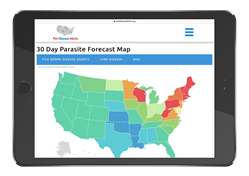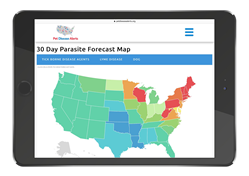
The new 30-Day Pet Parasite Forecast Maps at PetDiseaseAlerts.org are designed to alert pet owners and veterinarians about vector-borne diseases before they occur.
The risk just isn’t worth it. Heartworm preventatives are affordable, safe and effective. This is why CAPC recommends pet owners in Alabama talk to local veterinarians about year-round protection from Heartworm – with annual testing and preventatives.
SALEM, Ore. (PRWEB)
May 04, 2022
The nonprofit Companion Animal Parasite Council (CAPC) — the nation’s leading source on parasitic diseases that threaten the health of pets and people — is forecasting high risk for heartworm disease in Mobile, Alabama, and throughout the state, with Mobile County on the highest alert for May 2022.
In its mission to monitor and report emerging threats to companion animals, CAPC developed 30-Day Pet Parasite Forecast Maps to alert pet owners of impending disease outbreaks in their local communities. These monthly forecast maps can be found at PetDiseaseAlerts.org and currently forecast four parasitic diseases (Heartworm, Lyme, Ehrlichiosis and Anaplasmosis) based on analysis of recent disease prevalence trends in every county across the United States.
“Heartworm disease is serious threat to pets in Alabama that are increasingly vulnerable to these debilitating and potentially fatal illneses,” said Dr. Rick Marrinson, DVM, and CAPC board member. “The new 30-Day Pet Parasite Forecast Maps at PetDiseaseAlerts.org are designed to alert pet owners and veterinarians about vector-borne diseases before they occur.”
Please click here for pre-packaged video news segment for download/use highlighting details outlined below:
-
Heartworm Disease Forecast in Alabama – May 2022
With warm weather and humidity on the rise in Alabama, so are mosquitos. Spring weather creates ideal breeding conditions for mosquitos, which can transmit heartworm larvae to pets. Heartworms are transmitted through the bite of an infected mosquito and can affect both dogs and cats, although the disease acts a bit differently in each. It only takes a single mosquito bite for a pet to become infected. Analysis of the 30-Day Pet Parasite Forecast Maps for the state of Alabama indicate the risk of heartworm disease in Mobile and throughout Mobile County are at a high threat level – actually even higher than usual as compared to historical risk – with the entire state on high alert.
- Why Should Pet Owners Be Concerned?
Heartworm disease is a serious condition in dogs and cats and is almost 100% preventable. If a dog is infected, heartworms can affect many organs including the heart, lungs, kidneys and liver. If left undetected or untreated, heartworms can be fatal to a pet.
It only takes a single mosquito bite for a pet to become infected with heartworm larvae. The larvae mature into adult worms in the heart and lungs, but can also affect other organs such as the liver and kidneys. Heartworms can grow up to 16 inches long and can live up to five to seven years, causing serious damage to vital organs over time.
Early in the disease, pets may not show any signs of infections. Veterinarians may suspect heartworms when a pet presents with coughing, trouble breathing or fatigue with exercise. Signs are often progressive over weeks to months, and if left untreated the infection can be fatal.
- What Should Pet Owners Do?
As we head into summer and spend more time outdoors with our pets, talk to your local veterinarian about monthly heartworm protection and annual testing for both heartworm antigens and microfilariae. Once infected, treatment can be very difficult and expensive for dogs, and there is no treatment for cats. So, it is much easier, and less expensive, to prevent heartworms.
Staying aware of the threat level of heartworm disease in your local community and areas where you travel with your pet is also important. The 30-Day Pet Parasite Forecasts at PetDiseaseAlerts.org are updated monthly so pet owners can identify risk areas at home and across the country before they occur. CAPC encourages pet owners and veterinarians to consult these maps regularly in order to protect pets and families from parasitic diseases.
“Most people consider their pets as family members and wouldn’t knowingly expose them to infection with a potentially fatal disease that can ultimately compromise the length and quality of their lives. Yet millions who fail to protect their pets every month from heartworm infection are doing just that,” adds Dr. Marrison. “The risk just isn’t worth it. Heartworm preventatives are affordable, safe and effective. This is why CAPC recommends all pets, no matter where they live, be tested annually and placed on heartworm preventatives year round.”
Recognized as the global expert in forecasting vector-borne diseases of U.S. companion animals, CAPC indicates that risks have increased nationally due to:
- Increased travel with pets
- Rehoming of pets due to natural disaster and the transportation of rescue pets
- Distribution and prevalence of vector (mosquito and tick) populations
- Shifting wildlife populations, and their incursion into newly developed and reclaimed areas
- Short- and long-term changes in climatic conditions
- Changes in habitat due to natural or human-induced processes
CAPC’s forecasts – supported by ongoing research by parasitologists and statisticians in leading academic institutions across the United States – highlight areas where more should be done to lower the risk of companion animals’ exposure to disease vectors, such as mosquitos and ticks. The foundation of these prevention strategies are recommendations that veterinarians and pet owners test their pets annually for disease and protect them with products that kill or repel mosquitos and ticks, as well as year-round heartworm prevention.
“Because of the zoonotic potential of parasitic diseases – meaning they can be transmitted from animals to humans – we created our 30-Day Pet Parasite Forecasts to alert communities of the risk to people and pets locally,” said Dr. Christopher Carpenter, DVM, and CEO of CAPC. “Over the years, we’ve seen the risk for parasitic diseases increase and expand into areas that have had historically lower prevalence. CAPC’s monthly Pet Parasite Forecasts are critical to alerting pet owners to the risks and reinforcing CAPC’s recommendation that all pets need to be annually tested and protected year-round.”
To view local 30-Day Pet Parasite Forecast Maps, as well as the daily Flea Forecast, visit http://www.petdiseasealerts.org.
How the Forecasts Are Created
The 30-Day CAPC Pet Parasite Forecast Maps are a collaborative effort from parasitologists and statisticians in leading academic institutions across the United States who engage in ongoing research and data interpretation to better understand and monitor vector-borne disease agent transmission and changing life cycles of parasites. The forecasts are based on many factors including temperature, precipitation and population density.
About Pet Disease Alerts
Pet Disease Alerts (http://www.petdiseasealerts.org) is a nonprofit focused on alerting pet owners to the threat of pet diseases in their local areas. Established by the Companion Animal Parasite Council (CAPC) in 2018, Pet Disease Alerts was founded to directly communicate crucial, time-sensitive information about disease threats, encouraging pet owners to be proactive by visiting their veterinarian to get their pets tested and protected.
About the Companion Animal Parasite Council
The Companion Animal Parasite Council (http://www.capcvet.org) is an independent not-for-profit foundation comprised of parasitologists, veterinarians, medical, public health and other professionals that provides information for the optimal control of internal and external parasites that threaten the health of pets and people. Formed in 2002, CAPC works to help veterinary professionals and pet owners develop the best practices in parasite management that protect pets from parasitic infections and reduce the risk of zoonotic parasite transmission.
###
Share article on social media or email:

